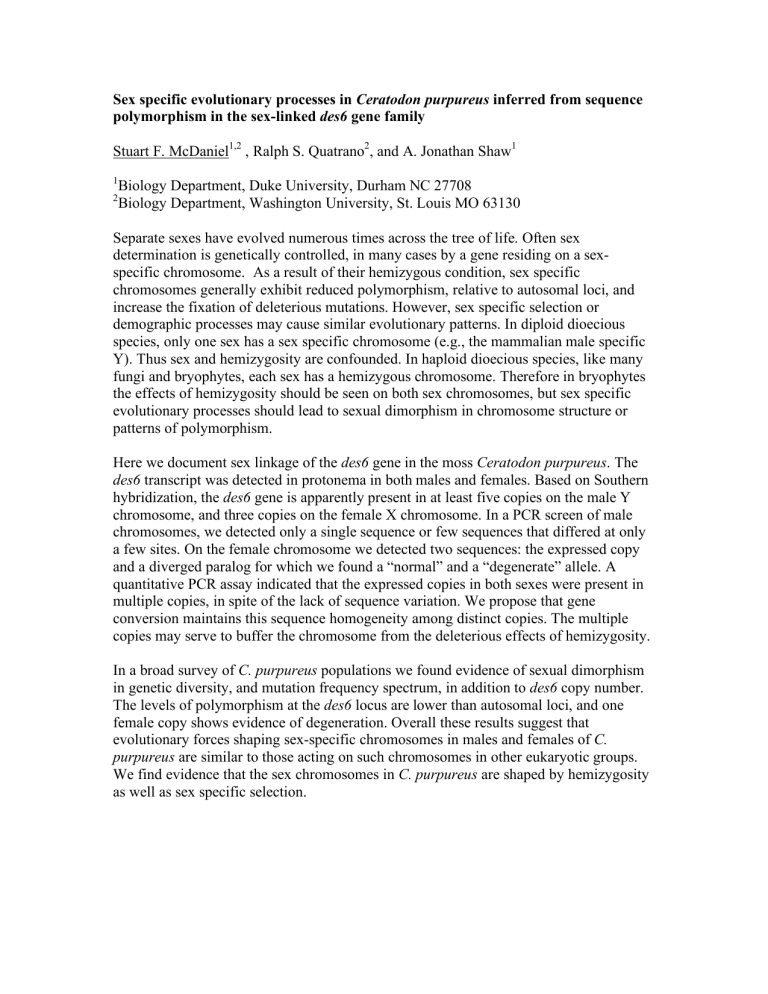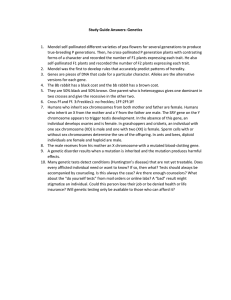Ceratodon purpureus des6 Stuart F. McDaniel

Sex specific evolutionary processes in Ceratodon purpureus inferred from sequence polymorphism in the sex-linked des6 gene family
1
Stuart F. McDaniel 1,2 , Ralph S. Quatrano 2 , and A. Jonathan Shaw 1
2
Biology Department, Duke University, Durham NC 27708
Biology Department, Washington University, St. Louis MO 63130
Separate sexes have evolved numerous times across the tree of life. Often sex determination is genetically controlled, in many cases by a gene residing on a sexspecific chromosome. As a result of their hemizygous condition, sex specific chromosomes generally exhibit reduced polymorphism, relative to autosomal loci, and increase the fixation of deleterious mutations. However, sex specific selection or demographic processes may cause similar evolutionary patterns. In diploid dioecious species, only one sex has a sex specific chromosome (e.g., the mammalian male specific
Y). Thus sex and hemizygosity are confounded. In haploid dioecious species, like many fungi and bryophytes, each sex has a hemizygous chromosome. Therefore in bryophytes the effects of hemizygosity should be seen on both sex chromosomes, but sex specific evolutionary processes should lead to sexual dimorphism in chromosome structure or patterns of polymorphism.
Here we document sex linkage of the des6 gene in the moss Ceratodon purpureus . The des6 transcript was detected in protonema in both males and females. Based on Southern hybridization, the des6 gene is apparently present in at least five copies on the male Y chromosome, and three copies on the female X chromosome. In a PCR screen of male chromosomes, we detected only a single sequence or few sequences that differed at only a few sites. On the female chromosome we detected two sequences: the expressed copy and a diverged paralog for which we found a “normal” and a “degenerate” allele. A quantitative PCR assay indicated that the expressed copies in both sexes were present in multiple copies, in spite of the lack of sequence variation. We propose that gene conversion maintains this sequence homogeneity among distinct copies. The multiple copies may serve to buffer the chromosome from the deleterious effects of hemizygosity.
In a broad survey of C. purpureus populations we found evidence of sexual dimorphism in genetic diversity, and mutation frequency spectrum, in addition to des6 copy number.
The levels of polymorphism at the des6 locus are lower than autosomal loci, and one female copy shows evidence of degeneration. Overall these results suggest that evolutionary forces shaping sex-specific chromosomes in males and females of C. purpureus are similar to those acting on such chromosomes in other eukaryotic groups.
We find evidence that the sex chromosomes in C. purpureus are shaped by hemizygosity as well as sex specific selection.








